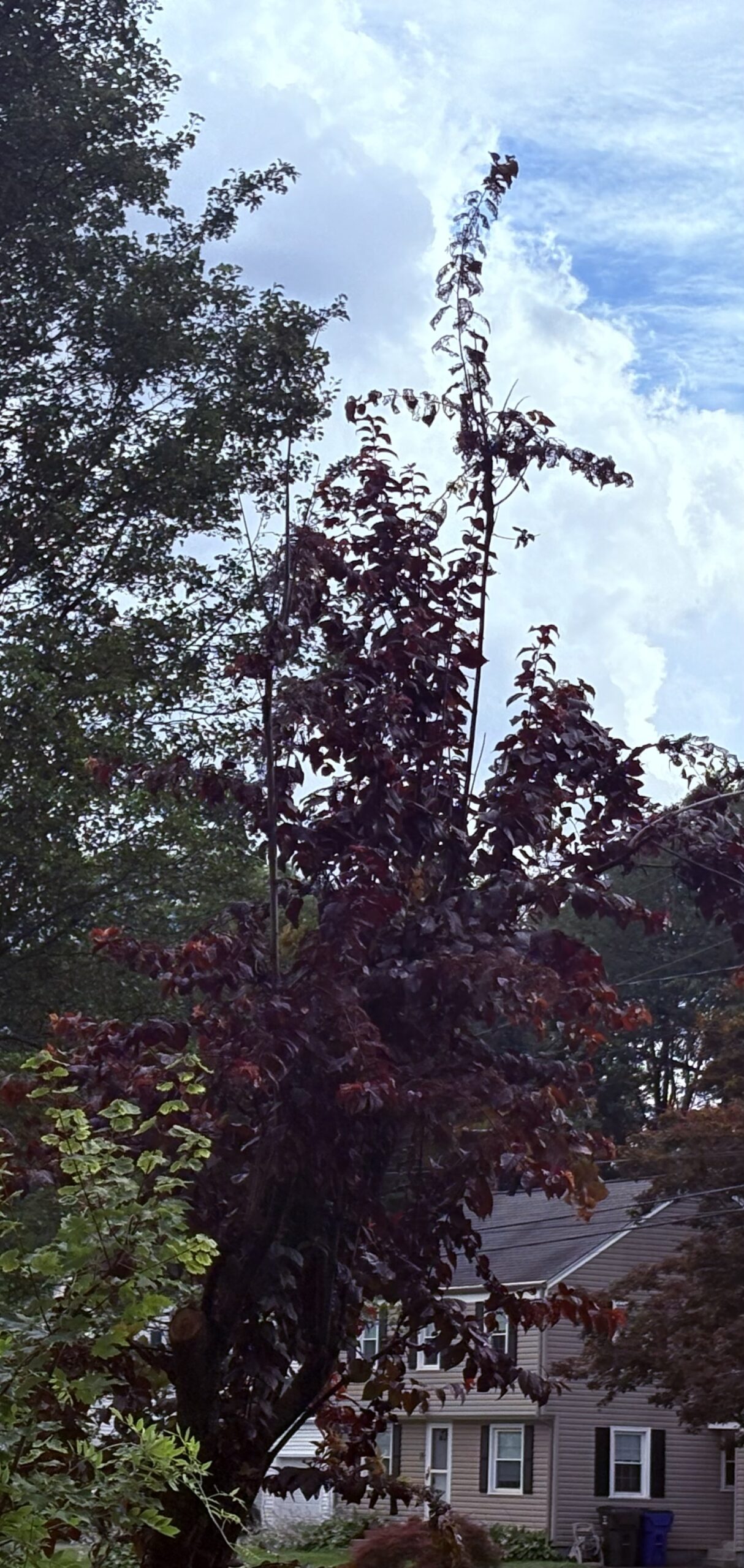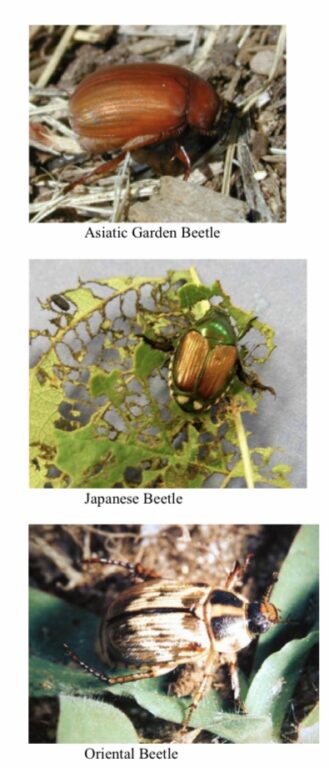Consumer Diary: Japanese and Other Beetles

Audio By Carbonatix

If you look at the leaves on the top of our severely pruned Japanese Cherry tree, you’ll see that they’re all lace-like from the recent invasion of Japanese beetles. Photo credit: Harlan Levy
Consumer columnist and West Hartford resident Harlan Levy has more than 20 years of experience writing stories about everyday experiences that anyone could encounter.

Harlan Levy. Courtesy photo
By Harlan Levy
THEY’RE BACK!
This is a warning for all West Hartford folks who have trees, herbaceous perennial plants, and flowers on their lawns.
Last week I was unpleasantly surprised to see many of the leaves of our severely trimmed Japanese cherry tree looking like theyʼd become lace up to the top. This was bad news.
During late winter ,our tree guy had radically pruned a majority of its branches because of a massive proliferation of the dreaded Black Knot disease. The result was almost shocking, but he assured us that the tree would come back and flourish. Indeed, by late spring all the branches had sprouted beautiful leaves. But now a new threat was decimating the leaves.
I immediately called our tree spraying guy, Martin McGuane of McGuane’s Landscaping, who came over the next day, looked over the leaves, and declared that the dreaded Japanese beetles had invaded and were making a comeback after a long hiatus. “They were all over your cherry tree,” he told me. “They were largely missing for a long while, but now they’re everywhere.”
He then sprayed the entire tree and said they wouldn’t be back for a while.
White grubs (fitting name)
White grubs (the larval stage of various types of beetles) are the most destructive of all pests to home lawns in Connecticut according to the Connecticut Agricultural Experiment Station.
So I called CAESʼs Katherine Dugas to find out about Japanese beetles and the other three species of adult White grubs. Hereʼs what I learned:
- For many years the Japanese beetle was the most common, but the Oriental beetle, Asiatic garden beetle, and European chafer have become more numerous in the last decade.
- Grubs eat roots near the soil line causing large dead patches in late summer and fall. Without the water and nutrients supplied by their roots, the grass declines and may die.
- Damage is more pronounced and widespread if conditions are hot and dry. While they are a major problem in turf, white grubs also feed on herbaceous and woody ornamental plant roots. Oriental beetles are the most common species found in landscape beds.
- Adult beetles feed on the leaves and flowers of many herbaceous and woody plants, giving them a ragged appearance. Japanese beetle adults feed during the heat of the day, skeletonizing the leaves of many plants. Their favorites are roses, grapes, and linden trees. Asiatic garden beetle adults feed at night from the leaf margin inward on many herbaceous perennial plants, favoring daisies and their relatives. Oriental beetle adults feed on the flowers of rose, squash, dahlia, and day lily and often congregate in swimming pools where they can be so numerous that they clog filters. European chafer adults do little feeding but can become a nuisance, often collecting in chimneys during their mating flights.
“Yes, they’re definitely active now,” Dugas told me. “My technician counterpart over in the Plant Disease Information Office had several of her garden plants chewed to stems by Asiatic garden beetles the other night.”
Monitoring and control these beetles involves timing, as they are active at different times of day, she said.
Japanese beetles will be actively feeding during the daylight hours, but Asiatic garden and Oriental beetles are nocturnal.
- All white grubs are cream colored with dark patches because of the soil they ingest. Three pairs of jointed legs are found just behind the reddish-brown head capsule. Grubs can reach up to one inch in length and are usually found curled up in C-shapes, especially when disturbed. European chafers are the largest and Asiatic garden beetles are the smallest.
- The European chafer is tan to brown, 5/8-inches long with a heavy body.
- Japanese beetles are metallic with copper- colored wings, a green head and patches of white hair along each side of their ½-inch-long body.
- The Oriental beetle is ½-inch long and straw-colored with irregular black patches which can cover the entire beetle.
- Asiatic garden beetles are 3/8 inches long, heavy bodied, and reddish-brown with a faint iridescence.

Courtesy of the Connecticut Agricultural Experiment Station
Life cycle
These beetles have a one-year life cycle in Connecticut. Winter is passed as partially-grown grubs in the soil below the frost line. As the soil warms in spring, grubs move back up into the root zone to resume feeding. Pupation occurs in May, and adult beetles emerge in June or July depending on the species.
European chafers conduct mating flights at dusk near trees or chimneys. Japanese beetles can be seen mating at their feeding sites during the day.
Asiatic garden beetles are nocturnal and, along with Oriental beetles, will come to lights at night. After mating, females lay eggs in moist soil in turf or nearby landscape beds. Adults live from six weeks up to four months.
Eggs absorb moisture during development and hatch in one to two weeks, depending on soil temperature. Small grubs begin feeding on roots. As their mouthparts get larger, they are able to completely sever roots.
Managenment
- Vigorous turf can usually tolerate some grubs. Maintain good vigor with annual fertilization and periodic liming based on soil test results. Mow on a regular basis, but cut off no more than a third of the grass blade height each time to avoid turf stress. High maintenance lawns that receive multiple fertilizations and frequent irrigation during the summer months may develop a thick thatch layer, found between grass blades and the soil line, which can limit percolation of water and fertilizers as well as movement of any needed insecticides. Dethatch with a mechanical rake to keep thatch ¼ to ½-inch.
- Biological control of White grubs using bacteria can be effective, said CAESʼs Rose Hiskes. Milky disease, caused by native bacteria, can infect European chafer, Japanese, and Oriental beetle grubs, she said, but this disease has not been effective in controlling White grubs in home lawns in Connecticut.
- A more recent discovery is Bacillus thuringiensis galleriae (Btg, sold as GrubGONE!). Btg can be effective against early-, mid- and last-instar grubs, as long as the product is applied while grubs are still actively feeding, as they must ingest the bacteria to be affected. Btg will attack the Asiatic garden beetle grubs which milky disease does not.
- Beneficial nematodes, microscopic roundworms, can be watered in to the soil where they enter white grubs. Once inside the grub, the nematodes release a bacterium that actually kills the grub. Because they are living organisms that dry out quickly and die if exposed to sunlight, they need to be applied on cloudy, calm days or in the early morning or evening or in the rain. Nematodes need to be applied by mid- to late-August to protect turf. Nematodes require one-half inch or more of rain or irrigation to incorporate them so they will be present at a depth where they will interact with newly-hatched grubs.
Chemicals
The most effective chemicals work only on newly-hatched larvae, which are barely visible to the naked eye. Therefore, waiting to apply insecticides until mature grubs are detected in late summer or early fall prevents adequate control. If monitoring detects a damaging population of white grubs that is causing dead patches in the lawn, application of a preventative insecticide to the next generation the next year may be the most effective way to manage White grubs.
Since the early 1990s, neonicotinoid insecticides, such as imidacloprid, have been the mainstay for preventive control of White grubs. However, concern about the risk of adverse effects to pollinators feeding on flowering plants growing in lawns, led to these products becoming restricted in Connecticut in 2016. The most commonly used alternative contains chlorantraniliprole (Grubex), which is virtually non-toxic to bees and vertebrates and is available to homeowners. For both the neonicotinoids and chlorantraniliprole products, the correct timing of application is immediately prior to significant rainfall between May and the last week of July. If needed, irrigating the lawn with ½” of water can take the place of rainfall. The insecticide will stay active in the soil and kill the next generation of grubs when they hatch in August.
Japanese beetles and Asiatic garden beetles are the only species that congregate on plants in large numbers where sprays might provide effective control. Older insecticides, such as Sevin, which is very toxic to bees, and malathion, have good activity against adult beetles. All are somewhat toxic to the applicator and environment. Pyrethrins, such as bifenthrin and cyfluthrin, which are derived from plants, are less toxic to mammals but are effective against insects in general.
Now you know … probably more than you wanted to.
Advice: Ask a licensed arborist to check out your garden and trees.
NOTE: If you have a consumer problem, contact me at [email protected] (“Consumer” in subject line), and, with the power of the press, maybe I can help.
Like what you see here? Click here to subscribe to We-Ha’s newsletter so you’ll always be in the know about what’s happening in West Hartford! Click the blue button below to become a supporter of We-Ha.com and our efforts to continue producing quality journalism.



